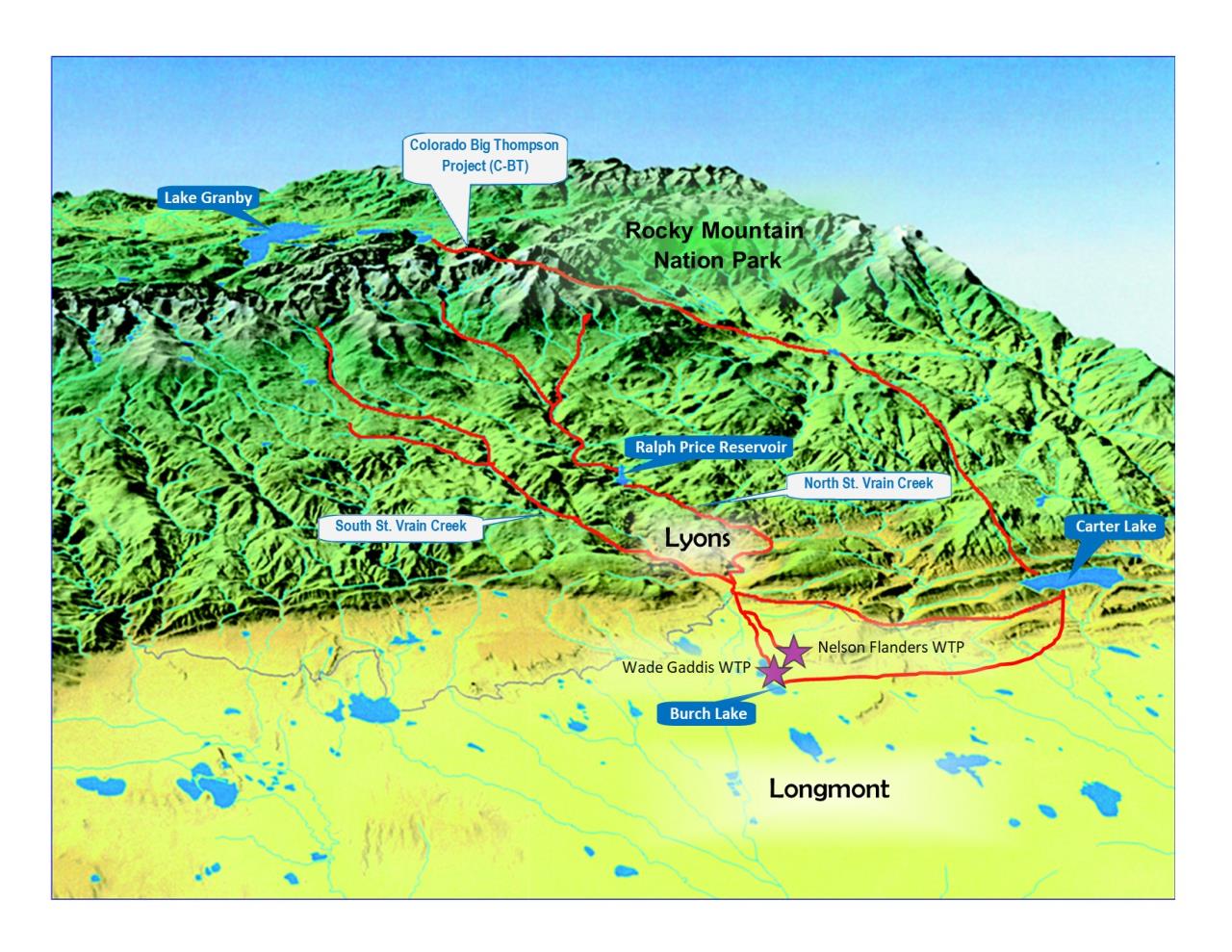Water Resources & Supply
Water Resources & Supply
 Where Does Longmont Get Its Water?
Where Does Longmont Get Its Water?
The City of Longmont’s drinking water is all surface water that comes from streams, lakes, and reservoirs that are fed by snowmelt and rainfall in the St. Vrain Creek watershed and the Colorado and Fraser Rivers on the west slope.
The North St. Vrain Creek watershed stores water in the Ralph Price Reservoir while the South St. Vrain Creek watershed stores water in Burch Lake. The North and South forks combine to form the St. Vrain Creek near the town of Lyons. From there, the Highland and the Palmerton Ditches are used to carry water from the St. Vrain Creek to our treatment centers.
Water from the Colorado and Fraser Rivers in Grand County is delivered to Longmont via the Colorado-Big Thompson (C-BT) project, operated by the Northern Colorado Water Conservancy District. Water from reservoirs in Grand County flows through the Adams Tunnel and is delivered to Longmont through Carter Lake via the St. Vrain Supply Canal and Southern Water Supply Pipeline.
History of Longmont’s Water Utilities
The first settlement in the present-day Longmont area was a trading fort built by Ceran St. Vrain and the Brent brothers in 1838. Settlers began to set up residences along the St. Vrain River, using stream water for their domestic needs. As the colony grew, a few individuals went into business hauling water from the streams which customers stored in large barrels or cisterns. A town pump was located in the center of town at the corner of 4th and Main Streets. On September 8, 1879, the 300 block of Main Street caught fire and was completely destroyed. The only water for fighting the fire came from the town pump and a bucket brigade that formed from the St. Vrain Creek. The fire led to the formation of the first fire fighting company in 1880. The fire of 1879 and the recognized need for a clean water supply were the impetus for developing a water system. On April 1, 1882, the Longmont taxpayers voted a $70,000 bond to build the first pressurized waterworks system.
Water Supply and Drought Management Plan
Longmont Drought Supply Response Level: Sustainable Conservation Level
Longmont is currently at the sustainable conservation level. At the sustainable conservation level the City will continue to implement Best Management Practices to conserve the water resources of the City. To learn how you can save water, visit the Water Conservation pages.
Learn more about Colorado’s drought status.
In an ongoing effort to inform residents and City Council about Longmont’s projected available water supply and demand, staff first began preparing a formalized Water Supply & Drought Management Plan during the drought of 2002. This plan has been annually reviewed and adopted by City Council since that time.
Read the current City of Longmont Water Supply and Drought Management Plan
Longmont’s Guiding Water Principles
Longmont has a set of 12 formal Guiding Water Principles that inform the operation and management of the water utility. Read the Guiding Water Principles.
The Water Resources department is currently working on a number of projects that will ensure the City has enough water to meet demands. Learn more about the current projects below.
Nelson-Flanders Water Treatment Plan Expansion
Learn about the planned expansion to ensure we fully support the drinking water needs of current and future Longmont residents.
Price Park Tank Replacement
Learn about this project that will construct a larger tank, new pumps and control equipment that will improve the ability to deliver water to the City to meet current and future needs.
Reservoirs
Learn about the different reservoirs that serve water to the City of Longmont customers and the related recreation opportunities.
Union Reservoir Enlargement Project
Learn about this project which will increase the reservoir from its current 12,000 acre feet capacity to a total of 32,000 acre feet.
Water Demand Evaluation Update
Read the 2019 Water Demand Evaluation Update from the City of Longmont.
Windy Gap Firming Project
Learn about the development of the Chimney Hollow Reservoir west of Carter Lake, to provide storage capacity to meet current and future water supply needs.
Longmont has a varied and extensive portfolio of water rights that include decrees for pipelines, storage reservoirs, irrigation rights, and contract rights as well as conditional decrees and applications filed in Water Court for additional decrees.
Water Rights are acquired primarily through implementation of the Raw Water Requirement Policy, which was adopted by the City Council in 1964. This policy provides the method whereby the City will acquire water rights in such quantity and of such quality as to provide a safe and reliable water supply for present and future water users under a wide range of hydrologic conditions. This policy provides the method in which the owners of properties with insufficient historic water rights to meet the requirements of the Raw Water Requirement Policy may satisfy the requirements in the policy by the payment of cash-in-lieu of water rights. Download the Cash-in-lieu history (PDF, 62 KB).
Use one affidavit for each ditch company. Show minimum of last 10 years consecutive use.
Raw Water Master Plan
The Raw Water Requirement Policy can be found in Title 14, Public Services, Chapter 14.05 of the Municipal Code. Download the Municipal Code.
The City of Longmont is increasing the cost of this cash-in-lieu fee from the current $48,500 per acre-foot to $59,625 per acre-foot. This increase will become effective on May 1, 2025 pursuant to City Council Resolution R-2025-05. The City uses these funds to acquire raw water, either in the form of outright acquisition of water rights or through the construction of water supply projects.
